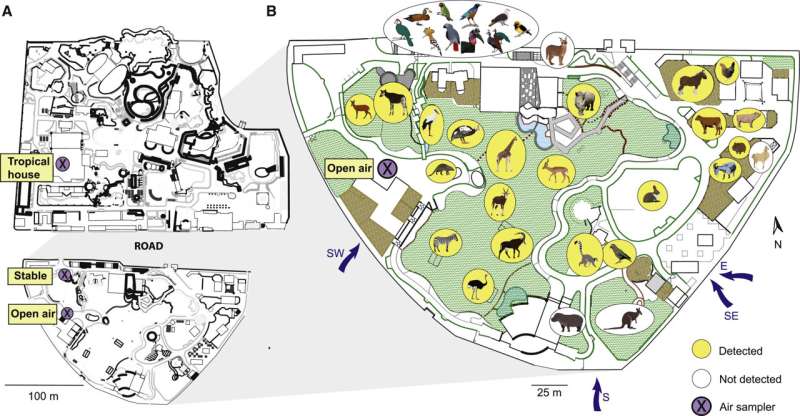This article has been reviewed according to Science X's editorial process and policies. Editors have highlighted the following attributes while ensuring the content's credibility:
fact-checked
peer-reviewed publication
trusted source
proofread
Scientists vacuum animal DNA from air in a Danish forest

It is an early autumn morning. Three researchers from the Globe Institute at the University of Copenhagen venture into a Danish forest carrying plastic boxes with DNA air samplers. Wearing latex gloves and face masks, the researchers strap the samplers to tree trunks and attach air filters. They then turn on the power. A faint hum reveals that the collection of airborne particles is in progress.
During the following three days, the researchers returned to the forest to change the air filters several times.
"We saw relatively few animals in the short time we spent in the forest when we changed the air filters. A squirrel, the sound of a woodpecker, a pheasant squawking and a white-tailed eagle flying above us one day," says Postdoc Christina Lynggaard.
What the researchers did not notice in the forest, they saw when they sequenced the airborne DNA particles collected on the filters. In just three days of 'vacuuming' in an area of the forest roughly the size of a football field, the researchers found DNA traces from 64 animal species. Some of them were domestic animals such as cow, pig, sheep, chicken and dog and exotic pets such as parakeet and peacock. But in addition, the researchers recorded around 50 terrestrial wild animals.
The wild animals spanned small and large animals and animals with different lifestyles—red deer, roe deer, Eurasian badger, white-tailed eagle, red fox, different vole species, robin, Eurasian red squirrel, common toad, smooth newt, great crested newt, crane, great spotted woodpecker, nuthatch, gray heron, marsh tit, woodcock—and many more.
In a short time, the researchers found almost a quarter of the land-living animals previously recorded in and around the area.
"It's absolutely crazy. Although we have worked hard to optimize the method, we did not dare to hope for such good results. We didn't think we would succeed so well in the very first attempt in nature," says Associate Professor Kristine Bohmann.
Animal DNA in the air around us
The DNA that the researchers vacuumed from the air is the so-called environmental DNA.
"Animals secrete DNA into their surrounding environment all the time. It could be in the form of fragments of hair, feathers and skin cells. If they are airborne, we can vacuum them and use DNA analyses to find out which animals they came from," says Christina Lynggaard.
The new results follow the researchers' ground-breaking study from last year where they showed that animal DNA can be vacuumed from the air in a zoo. They used it to map the presence of many of the animals in Copenhagen Zoo.
"There is quite a difference between a zoo and nature," says Kristine Bohmann. "In a zoo, the animals are present in large numbers in a relatively small area, while in nature they are much less concentrated. Therefore, we were unsure how well we could make the method work in nature. And that is where we have to get it to work if we want to use it to monitor biodiversity."
A valuable tool
"We are in a biodiversity crisis, and tools are needed to understand how ecosystems change as a result of human impacts, to guide management strategies and to assess the risk of the spread of diseases in areas where animals can come into contact with people," says Christina Lynggaard.
The researchers' first results from vacuuming in nature show that airborne environmental DNA can be an effective method for mapping the presence of wild animals.
"As with all new methods, we have a lot of work ahead of us. But this study makes us hopeful. It demonstrates a sensitive method for mapping the presence of animals without having to see or disturb them," says Kristine Bohmann.
In the study, the researchers work with airborne environmental DNA in very small quantities. And because this is the first study to demonstrate the use of air filtration to detect the presence of a wide range of wildlife, the researchers went to great lengths to verify the findings.
"When we first detected DNA from peacocks, we were afraid that it might be a mistake. I therefore called around to find out if anyone who lived near the collection site had knowledge of peacocks in the area. Fortunately, they said that they had sometimes come across a peacock when they went for a walk," says Kristine Bohmann, who in this way was able to verify the otherwise somewhat unusual DNA find.
The study has just been published in Molecular Ecology Resources.
More information: Christina Lynggaard et al, Airborne environmental DNA captures terrestrial vertebrate diversity in nature, Molecular Ecology Resources (2023). DOI: 10.1111/1755-0998.13840
Journal information: Molecular Ecology Resources
Provided by University of Copenhagen



















